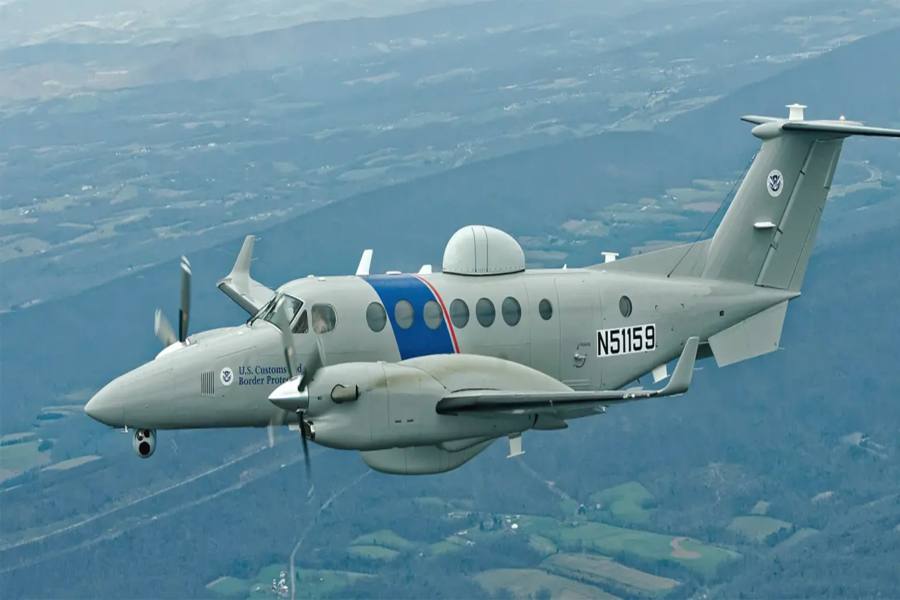A United States Air Force pilot reported a close encounter with an unidentified flying object (UFO) while flying through controlled airspace over California during a classified mission in September 2023. The incident came to light through newly leaked audio obtained by NewsNation’s Banfield, raising new questions about the presence of unexplained aerial phenomena in restricted airspace.
The pilot, flying a Beechcraft 350 C under the call sign “Troy 21,” was conducting a mission tied to the Department of Homeland Security when he reported the sighting to Los Angeles air traffic control. According to the recording, the pilot calmly stated, “This is going to sound weird, but I just had something pass underneath my wing. Maybe a football-sized object right under my wing.” The sighting occurred around 2:30 p.m. in clear weather, at an altitude of 20,000 feet.
The object, described by the pilot as cylindrical, dark gray, and roughly the size of a football, reportedly flew just 10 feet beneath the aircraft’s right wing. Given the altitude and controlled nature of the airspace, the object’s presence has sparked speculation and concern among experts. When questioned by the air traffic controller if the object might have been a drone, the pilot responded that he was unsure. While certain high-performance military or advanced hobbyist drones can reach such altitudes, aviation experts interviewed by NewsNation emphasized that this is highly uncommon.
The pilot immediately tasked his onboard sensor operator to attempt to locate the object on camera. Moments later, the pilot reported a separate object appearing on the aircraft’s air-to-air tracking system. Approximately 40 seconds after that, a radar signal picked up another unidentified object 60 miles from the plane’s location. Analysts have pointed out that for the objects to be one and the same, it would need to have traveled more than 60 miles in less than a minute—an indication it may have been moving at speeds exceeding Mach 2, or over 1,500 miles per hour.
The rapid progression of events from visual identification to sensor tracking to radar detection has added credibility to the pilot’s report. Audio from the incident later captured a second air traffic controller casually noting, “There was a UFO reported here, but that’s all taken care of now.” It remains unclear what follow-up procedures, if any, were enacted at the time. However, NewsNation reported that the sighting was eventually forwarded to the National UFO Reporting Center (NUFORC), a private organization that documents and investigates UFO sightings across the United States.
The September incident bears a striking resemblance to another recent report made by former NASA astronaut Leroy Chiao. In the summer of 2023, Chiao was piloting his aircraft over the Texas panhandle when he encountered two metallic, cylindrical objects that passed roughly 10 feet below his wings. Chiao, who has spent over 229 days in space, said the objects had no visible propulsion systems and did not resemble any aircraft or drone he had ever seen. “There was nothing around me other than the panhandle of Texas at 9,000 feet on this instrument flight plan,” Chiao told the New York Post. “And just suddenly these things appeared. They came right at me.”
Both incidents involve cylindrical aerial objects appearing without warning at altitudes where few unregistered or unidentified aircraft are expected. Neither pilot could confirm the identity of the objects, and both described encounters happening in moments of complete atmospheric clarity, ruling out common causes such as birds or debris.
Encounters like these are becoming increasingly public as government agencies take more formal steps to monitor and investigate unidentified aerial phenomena (UAPs). In 2021, the Department of Defense established the All-domain Anomaly Resolution Office (AARO) to gather, analyze, and respond to reports of UAPs that may present threats to U.S. national security. The Pentagon has acknowledged the legitimacy of certain military encounters with UAPs and has released select footage, though definitive explanations remain elusive.
What makes the “Troy 21” incident particularly compelling is the pilot’s composure and clarity during the sighting, combined with the multi-layered confirmation from both onboard sensors and radar systems. The event occurred during a classified Department of Homeland Security flight, raising further intrigue, as military flights are conducted under strict operational guidelines, and the surrounding airspace is typically monitored with heightened precision.
The unidentified object’s close proximity—within 10 feet of a government aircraft—also presents a potential safety concern. Whether the object was a previously undetected drone, experimental aircraft, or something entirely unknown, it had entered controlled airspace without authorization and passed dangerously close to a crewed flight. The Air Force and FAA have not commented publicly on the event, and no formal report has been released to confirm whether further investigation is underway.
As reports of UAPs continue to grow—both in number and credibility—the demand for transparency from federal agencies has increased. Congressional hearings, classified briefings, and public pressure have brought the subject of UFOs into the mainstream. While some reports have turned out to be misidentified drones or natural phenomena, many others, such as this recent incident, remain unresolved.
With technology advancing and the skies more surveilled than ever, the persistence of unexplained aerial events continues to puzzle experts and fuel speculation. The object seen by “Troy 21” remains unidentified, joining a growing list of sightings that challenge our understanding of what’s flying above us.
Whether it was a foreign surveillance tool, a classified domestic drone, or something beyond conventional explanation, the encounter over California reminds us that our skies are not always as empty—or as understood-as we might believe. As more information surfaces and similar events are documented, the mystery surrounding these objects only deepens, urging both the public and government to look up and ask questions.
